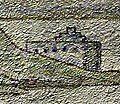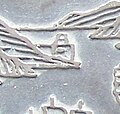User:Blcksx/sandbox
What the structure isn't
[edit]In October of 1952, a large bronze version of the seal was placed at the west steps of the California State Capitol in Sacramento. In such a prominent spot, this seal is seen by hundreds of thousands of visitors every year, and the size of the seal guarantees that an observer cannot miss the building. Over the years, a rumor about the identity of the building grew and is still told, and runs something like this:
| “ | You'll notice the building in the upper-left of the seal, which doesn't appear on any other seal here at the Capitol. This seal was created by prisoners at San Quentin State Prison, who wished to sign their names to it as the artists. However, they were refused by the warden -- they were prisoners, after all -- and in response, snuck the building into this seal as a clandestine signature. It represents the chapel at the prison, and wasn't noticed until it was too late to do anything about it. | ” |
Although this 3,400 pound, nearly ten foot wide seal was created by inmates in the foundry at San Quentin,[1] the rest of the rumor is, at best, questionable. Five facts stand in the way of this rumor being true:
- If the building is taken as San Quentin and if the break in the mountains is taken to be the Golden Gate, then the view must be of the San Francisco Bay Area, looking from east to west. That places the building on the wrong side of the Gate to be San Quentin.
- No building in this form, including the chapel, has ever existed at San Quentin.
- The building first appeared in artistic renditions of the seal as early as 1890, decades before this seal was cast in 1952, and was officially added in the 1937 standardization. (Thirteen pre-1952 examples that include the building are shown in this article.) The seals in the Capitol that do not include the building (and there are some that do) were created before 1937.
- The configuration of the building on this seal is strikingly similar to its appearance in the 1937 standardization, which itself was based on the 1895 Blue Book rendition.
- Three detailed, post-1952 accounts of the Seal, including a 1960 newspaper article that describes the creation of the bronze Seal at San Quentin, make no mention of the rumor.[2][3][4]
The mysterious building
[edit]Also in the 1937 seal there is a building on the far left rear hill that has been interpreted in a variety of ways. The building, along with the break in the mountains, may have been added to give San Francisco Bay a stronger claim on its location being the landscape portrayed in the seal.[5] This building first appeared in unofficial versions of the seal in the 1890s, and in most of these, the building was clearly meant to represent Fort Point in San Francisco.[6][7]
Interpretations as Fort Point
-
A mid-1800s image of Fort Point for comparison with representations of the fort on the following renditions of the Seal of California
-
California State Letterhead (1890): Printed by a San Francisco lithographer (courtesy of John Allen)
-
James Lick Pioneer Monument, San Francisco (1894)
-
So-Called Dollar HK-249 (Artistic Rendition): Issued for the 1894 Midwinter Fair held in San Francisco
-
Spanish-American War Flag at the California State Archives, Sacramento (ca. 1898): Given to American soldiers on their way to the Philippines via the Presidio in San Francisco
However, the structure was given an apparent dome in the 1895 edition of the California Blue Book,[8] and it was in this configuration that the building appeared in the 1937 standardization of the official seal. Fort Point has no dome, and it is unknown what building the 1895 artist was attempting to portray.[9] In 1952, the now officially sanctioned structure was cast in bronze in the large seal at the west steps of the California State Capitol in Sacramento.[10]
The building receives a dome
-
California Blue Book (1895)
-
1937 Standardization
-
On the west steps of the California State Capitol, Sacramento (1952)

The source of this story has yet to come to light, although it is possibly related to the large seal attached to the Resources Building in downtown Sacramento, placed in 1964, just four years before the earliest known reference to the rumor in 1968.[11] This seal features what appears to be two structures combined into one. The right half, with some imagination, resembles the front gates of San Quentin State Prison, and the left half, with even more imagination, Folsom State Prison's Greystone Chapel. Why the artist portrayed the building in this fashion is another mystery. If the artist did mean for the building to be San Quentin and Folsom prisons, the rumor being mistakenly attached to the seal in front of the Capitol may have stemmed from a confusion of the two seals, which are only a few blocks from each other.[12] Whatever the building is, it is easily missed. Even the nearly exhaustive official color scheme for the seal (e.g., "the spear of Minerva shall be Oakwood, Cable No. 70094 and the tip white"), passed in 1967 -- thirty years after the structure was officially added -- failed to mention the building.[13]
Other interpretations of the mysterious building over the years
Because there is no official designation of the identity of the building, artists have interpreted the building in a number of ways.
-
San Mateo County History Museum, Redwood City (1910)
-
Veteran's Welfare Bond (1925): Here the building looks somewhat like the old State Capitol in Benicia
-
Room 500, Library and Courts I, Sacramento (ca. 1928)
-
Marc J. Rowe's Redesign (1928)
-
Lucile Lloyd Mural in Room 4203, California State Capitol, Sacramento (1937)
-
Ronald Reagan State Building, Los Angeles (1939): This seal was originally placed in front of the old State Building on First Street, demolished in 1975
-
East Entrance, California State Capitol, Sacramento (1950): Here in the O.C. Malmquist panels, the building takes on more of a Spanish mission look, exchanging the dome for a similarly-shaped curved roof line
-
State Personnel Board, Sacramento (1954): After more than fifty years, is this interpretation meant to be a return to Fort Point?
-
California State Archives, Sacramento (ca. 1956): Another possible throwback to Fort Point?
-
1304 O Street, Sacramento (1960): Many seals found on state buildings from approximately 1960-1980 do not show the building, which might explain why the 1967 official color scheme makes no mention of it
-
Elihu M. Harris State Building, Oakland (1998): Although this example is from twenty years later, this style of building had been in use as early as 1978[14]
-
Vietnam Memorial, Capitol Park, Sacramento (1988)
-
Family Law Courthouse, Riverside (Artistic Rendition) (1998): The building bears a resemblance to the Peace Tower, also in Riverside, California
-
Hiram Johnson State Building, San Francisco (ca. 1998): The building on this seal, in the building's auditorium, looks somewhat like one of the City's famous painted ladies Victorian homes
-
Governor's Office Reception Area Carpet, California State Capitol, Sacramento (ca. 1999)
-
CalTrans District 7 HQ, Los Angeles (2004): Another unusual interpretation
-
DMV, First Avenue, Sacramento (Present Day Two-Tone)
-
Department of Education, Sacramento (Present Day Full Color): The building has taken on more of a tower rather than a dome
- ^ California Blue Book (Sacramento: State Printing Office, 1958), 667
- ^ "State Seal a Product of Convicts," San Diego Union, 31 January 1960, A22
- ^ Letters Between J.N. Bowman and W.N. Davis, May 1962 (California State Archives, General Information Files, Seals -- Great Seal of California)
- ^ J.N. Bowman, "The Great Seal of California," 1963 (revision of his 1958 article "for some future edition" of the California Blue Book, California State Archives, General Information Files, Seals -- Great Seal of California)
- ^ J.N. Bowman, "The Great Seal of California," California Blue Book (Sacramento: State Printing Office, 1950), 159
- ^ The Seal of the City and County of San Francisco features a view of a ship steaming through the Golden Gate, and on each shore stands a structure. On the left is what appears to be Fort Point, and on the right, possibly Point Bonita Light. This seal, adopted by the San Francisco Board of Supervisors in 1859 ("Seal of the City and County of San Francisco," City and County of San Francisco, accessed 6 July 2011), may have influenced later artists of the state seal
- ^ Oddly, although the mosaic seal on the second floor of the Ferry Building is of the right place, San Francisco, and right era, 1890s, it does not include the building
- ^ California Blue Book (Sacramento: State Printing Office, 1895), 299
- ^ J.N. Bowman reported that the engraver of the 1937 master die, James Cairns, engraved "the object on the left point of land at the 'gate' ... as a fort." (J.N. Bowman, "The Great Seal of California," California Blue Book (Sacramento: State Printing Office, 1950), 165)
- ^ "The New Look," Sacramento Bee, 1 October 1952, 25
- ^ "[The students] noted a huge replica of the California State Seal, made by men of San Quentin of copper and iron. The inmates placed the prison chapel on the seal, although it wasn't supposed to be there." ("Eighth Graders Find Capital Exciting," (Eureka) Times-Standard, 9 June 1968, 6). But be careful with what you read: this article goes on to mention -- twice -- that the seal contains thirty-six stars to represent California being the thirty-sixth state. It was, in fact, the thirty-first
- ^ The rumor may have been given further credence by the 1988 discovery that a printing plate in use by prison labor on behalf of the state printing office gave Minerva's face the appearance of Snoopy, the famous cartoon beagle. At first it was believed that it was a prank by the inmates but later was found to have been caused unintentionally by a worn printing plate. ("That Character on State Seal NOT Snoopy," Modesto Bee, 1 April 1988, B4). In a similar vein, Vermont inmates working in the prison print shop made an unsanctioned change to the state police emblem door decal used on the sides of thirty police cruisers. One of the spots on the cow (which is supposed to be there) was altered to take the shape of a pig. (Zach Howard, "Vermont Inmates Hide Pig in Official Police Car Decal," Reuters, 2 February 2012, accessed 8 November 2012)
- ^ Statutes of California, 1967, chapter 919
- ^ Anne Lasky, "State Seal in Office Building," Los Angeles Public Library Images Database, accessed 11 June 2012


















![Elihu M. Harris State Building, Oakland (1998): Although this example is from twenty years later, this style of building had been in use as early as 1978[14]](http://upload.wikimedia.org/wikipedia/en/thumb/c/ce/Seal_of_California_%28Building_Detail%29%2C_1998%2C_Elihu_M._Harris_State_Building%2C_Oakland%2C_California.jpg/120px-Seal_of_California_%28Building_Detail%29%2C_1998%2C_Elihu_M._Harris_State_Building%2C_Oakland%2C_California.jpg)





